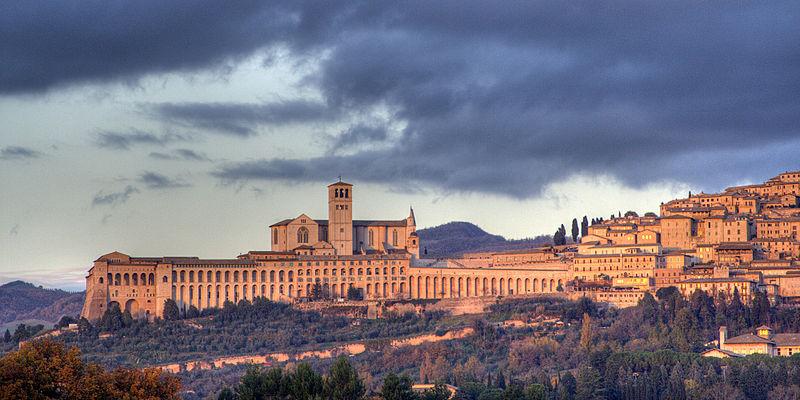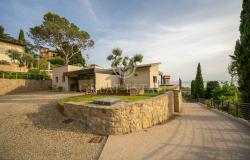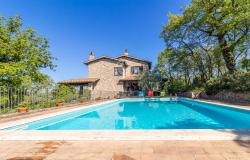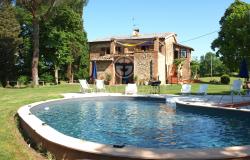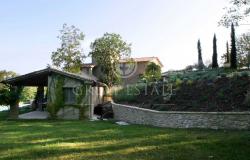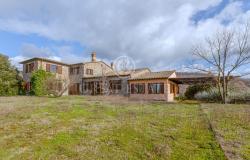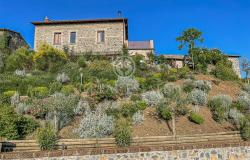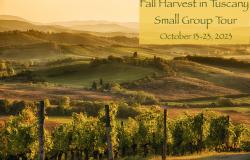The wind swept over the square outside the Upper Basilica, filling the sky with grey clouds. St Francis sat astride his horse with bowed head. This statue captures the moment when, in 1204, the saint heard the voice of God telling him to leave the war and return home. The grass shivered and swayed; the rain was not far away.
We hastened into the cathedral. Earlier that day we’d watched tourists arrive by the busload, the Franciscan friars who give tours around the basilica struggling to keep their herds together. However, it seems few visitors choose to stay overnight, especially as the days of autumn lengthen. By this late hour barely a handful of tourists wandered the aisles.

The Papal Basilica of St. Francis of Assisi comprises an upper and lower basilica. Pope Gregory IX laid the foundation stone of the Lower Basilica on 17th July 1228, a day after canonizing Giovanni Francesco di Bernardone (as St Francis was baptised). On completion of the Lower Basilica in 1230, St Francis’ body was brought from the Church of San Giorgio (now the Basilica of St Claire of Assisi) and buried in the Lower Basilica. Fearing the saint’s remains might be looted, the burial site was kept secret, and only in 1818 his remains were discovered below the floor. Subsequently, a crypt was built beneath the Lower Basilica.
The Upper Basilica, begun in 1239 and completed in 1253, is a light and spacious building. The beauty and serenity of the frescoes decorating the walls lie beyond description. They add to the basilicas tranquility; even when crowded, both churches remain quiet (unlike other Italian icons, such as the Duomo, St Marco’s, or even St Peter’s, all of which echo to the cacophony of tourists).

The frescoes are showpieces of the art history of the late medieval period, including such geniuses as the unknown Master of St Francis, plus Cimabue and his student, Giotto, as well as lesser known, and often anonymous, painters. The sheer amount of artwork can be overwhelming, but there is always a place to sit and concentrate on just a few frescoes in detail. (There are numerous pamphlets available describing the works, as well as audio headsets for hire.)
 The damage caused by the 1997 earthquakes is still visible. In the first aisle of the Upper Basilica alone, restorers had to work with some 300,000 pieces from the roof. Perhaps the most important work in the Upper Basilica is the cycle of 28 frescoes of the life St Francis, begun by Giotto at the age of 33. (Disputes still continue regarding the authorship of these and many other of the frescoes, as many documents relating to the Basilica were destroyed by Napoleon’s troops.) In these frescoes can be seen the birth of the Renaissance. Such realism had not been painted before, nor the harmony between god, man and nature. The individualism depicted in the works, such as the gentle nature of St Francis and his love of animals, and the intimate use of pictorial space lay broke the confines of medieval art.
The damage caused by the 1997 earthquakes is still visible. In the first aisle of the Upper Basilica alone, restorers had to work with some 300,000 pieces from the roof. Perhaps the most important work in the Upper Basilica is the cycle of 28 frescoes of the life St Francis, begun by Giotto at the age of 33. (Disputes still continue regarding the authorship of these and many other of the frescoes, as many documents relating to the Basilica were destroyed by Napoleon’s troops.) In these frescoes can be seen the birth of the Renaissance. Such realism had not been painted before, nor the harmony between god, man and nature. The individualism depicted in the works, such as the gentle nature of St Francis and his love of animals, and the intimate use of pictorial space lay broke the confines of medieval art.
Rain was falling as we traversed the cloister from the Upper to the Lower Basilica. It washed away the grime of travel; of trains and train stations, of not knowing which platform to go to, or of being exactly sure where to get off, or what bus to catch. But the magic of travelling through the Italian countryside remained. We’d passed small gardens crammed with all manner of vegetables, and hills covered with rows of olives and vines and Cyprus tress. Ochre houses and old stone farmhouses filled the landscape, and forgotten villages and old ruins dotted the hilltops. Every now and then a bell tower or the silhouette of a church rose against the skyline.

The oldest frescoes are in The Lower Basilica. Created in 1260 by the unknown Maestro di San Francesco, many consider these as the best examples of frescoes prior to Cimabue. As the fame of St Francis grew, the side chapels were commissioned by noble families, and the works in the Chapel of Teobaldo Pontano (dedicated to Mary Magdalene) contains work from the workshop of Giotto, if not by Giotto himself.
Halfway down the central nave steps lead to the stone crypt, where St Francis is buried. Dark but peaceful, it is filled with incense and the flickering of candles. His simple coffin is entombed above a bare stone altar, which rises as a pillar in the centre of the crypt. Behind a grille in the pillar lie hundreds of photos. His four most faithful fellow-friars are also buried here: Friar Leone, Friar Masseo, Friar Angelo and Friar Ruffino. On the stairway, facing the tomb, are the remains of Jacoa of Settesoli, a friend and benefactor whom St Francis called Friar Jacoba.

The peace of the crypt is palpable. Pax et bonum (peace and the good, the motto of St Francis), it is everywhere. Despite the hour, many people knelt before the tomb: nuns, monks, priests, schoolchildren, tourists. It is possible to walk around the tomb whilst others venerate, and there are plenty of pews offering places for solitude.
The Lower Basilica exits onto a grand courtyard. Looking back up over the Basilica the two buildings seem as one, majestically carved into the mountainside. It gives a contrasting view to the quiet square outside the Upper Basilica. Yet even leaving via this grand way, as afternoon falls, a peace settles over the town and away from the main thoroughfares we were often the only ones on the streets.

The next morning I woke as a watery sun crept through the window. Yesterday I’d looked over terracotta rooftops to a countryside so classic as to be breathtaking. Now everything lay hidden; spires and steeples appeared and disappeared as a breeze stirred the early mist. An occasional bell sounded, calling the faithful to mass.
As the world slept I made my way towards the basilica. A cold wind crept through my clothes. A few people passed by, more shadows than reality at that early hour. The courtyard outside the Upper Basilica was bare and windswept. The upper church was closed – in the Lower Basilica, an early Mass was in progress around the main altar, the stall behind it filled with priests. A few tardy nuns hurried to their seats.

Sitting in the Basilica at that hour cocooned me in a world of tranquility, far removed from the real world. Assisi feels as if it floats even above the hilltops. It is a town of steep streets and quiet corners, of bustling squares and cafes adjacent to forgotten ruins. Yet from the first sighting of the Basilica when arriving in the valley far below, the words of St Francis become tangible: pax et bonum, peace and goodwill.
Check out our Foodie Fun in Umbria, read our interview to Friar Alessandro or practice Italian with a dual language article on San Francesco.
More news about Umbria
Information about Umbria's Wines and Extra Virgin Olive Oil
Map of Umbria
Accommodation in Umbria
